Congratulations to Mark Weidhase for setting 5 new Trike records in the Male 50-59 Para C5 category on Feb 27, 2021
Mark set the following records:
| Distance Event Kilometers | Time | Avg Sp (Km) | Avg Sp (Miles) | |
| 100 Kilometer road | 04:35:39.03 | 21.77 | 13.53 | |
| 200 Kilometer road | 09:29:50.43 | 21.06 | 13.09 | |
| Distance Event Miles | Time | Avg Sp (Miles) | Avg Sp (Km) | |
| 100 Mile road | 07:14:45.37 | 13.80 | 22.21 | |
| Timed Event | Miles | Kilometers | Avg Sp (Miles) | Avg Sp (Km) |
| 6 Hour road | 82.444 | 132.680 | 13.74 | 22.11 |
| 12 Hour road | 153.306 | 246.722 | 12.78 | 20.56 |
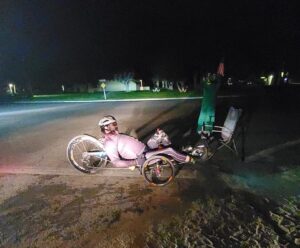
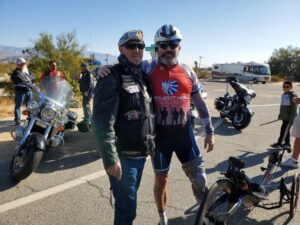
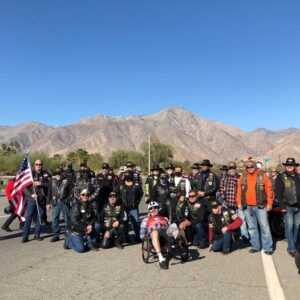
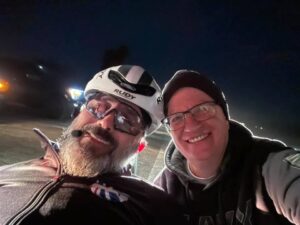
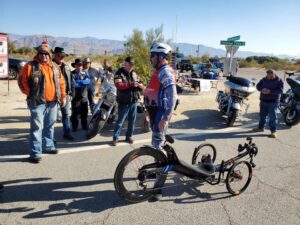
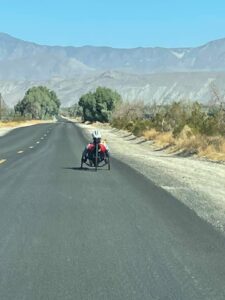
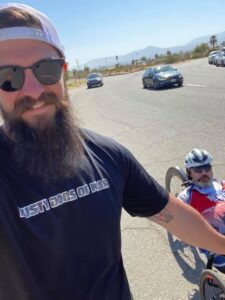
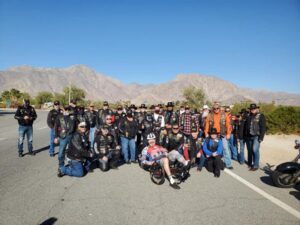
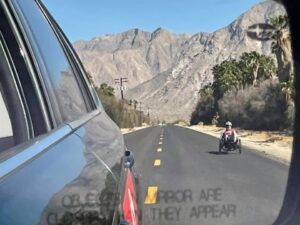
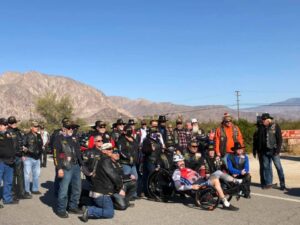
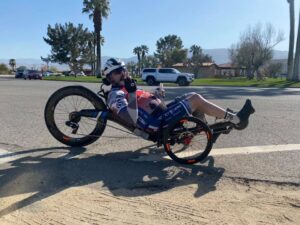

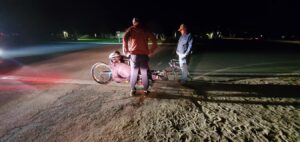
I, Mark Weidhase, am one of hundreds of disabled veterans who are forced to ride recumbent trikes due to health reasons. It was frustrating that we were placed in the same category as two wheeled recumbents where we really could never be competitive, simply because the world’s lightest recumbent trike weighs in at 29 pounds. WUCA is the first major cycling organization to create a separate category for recumbent trikes, which will hopefully lead to more participation in ultra-cycling events. The ride was supposed to start on February 27, 2021 at 09:00 Pacific Time but was slightly delayed as over 60 American Legion Riders has shown up on their motorcycles. While a welcome gesture, it delayed the start and final prep and I had issues getting the Garmin to recognize my right pedal.
I set off at 09:04 from the northeast cul de sac at Christmas Circle, also known as the start and finish of the WTTC. The weather was nice with abundant sunshine and temperatures that peaked in the high 70’s. I have an injured left leg and my Garmin was only giving me data for that leg. I now had to abandon my plan to ride a set power number, as my left leg only accounts for 20-30 percent of total power, and instead switched to heart rate and cadence. Part of my PTSD is a propensity for panic and anxiety attacks, which started just as I was getting underway on my Bacchetta Carbon Trike 2.0 with a rear Enve 7.8 wheel and wearing Rudy Project glasses and helmet. Honeystinger, Pactimo and Nuun all sponsored the attempt so all I had to worry about was slowing my breathing and riding my pace. I know that I am not the fastest, but the whole reason for setting the first recumbent trike WUCA world records was to inspire others to come out and break them. All records are meant to be broken. The first two laps were smooth but at the end of the second lap, I had to stop for a comfort break. Another symptom of PTSD and anxiety is diarrhea and, of course, I had it. I skipped my usual Ensure Plus and relied on just Nuun Endurance and water, so my stomach could settle down, but I had to stop again two laps later. I had now gone three laps without food and added a fourth. Each lap is comprised of the northern half of the WTTC long lap circuit and comes down to just over 10 miles. That came out to over 40 miles without any food and I averaged 36-42 minutes per lap and one bottle of Nuun Endurance and water per lap. We used a Vertix communications system to communicate between rider and car and a Bearcom rented handheld radio set to communicate between the car and the pits. This allowed the crew and officials to communicate without me hearing it and is the same system we used for Jennifer Orr’s 24 Hour record attempt in November 2020.
My body was craving something salty, and I asked for a handful of nuts. The nuts had not made it to the pit, so instead I was handed a small bag of trailmix. Well, that was not a good idea and my stomach promptly shut down. I was now dealing with bloat and nausea. I remembered my first Ultra, the Hoodoo 300, where the same thing happened. I retched and threw up bits and pieces, made another bathroom stop and eventually cleared the blockage. It was now dark, and a blood red, full moon was rising over the desert. Darkness also meant less vehicular traffic and dust. As anyone on a handcycle or recumbent trike can attest, we breathe far more particulate matter than uprights as the dust kicked up by other cars lingers in line with our heads. I took a moment to comment how lucky we all are to be able to do this but with temperatures falling quickly into the mid 30-s it was time to start layering. I was cold and asked for a bottle of bone broth which was my first nutrition in hours. I worked very well, and I pushed on. Even wearing my thickest jacket, it was cold and that is probably because laying backwards exposes more of the body to air flow. Just as I was thinking that things were turning around, my heart started an irregular rhythm and I was alerted by my Apple Watch to possible arterial fibrillation and an irregular heartbeat. I have a rare heart condition that has caused several heart attacks and is not something that can be repaired with a surgical intervention. I stopped for a nitroglycerin and blood pressure check by the nurse crew member. We decided it was safe to continue on. At some point during this time one or more of the loose bone fragments in my left knee caused the joint to lock. I experience this quite often and using force the lock can be broken. Sometimes that is it and sometimes it locks again and again. Each time I forced the leg to break the lock is a micro fracture of the joint surfaces and quite painful. I was able to push for a while, but the pain was causing me to see double and slow down quite drastically. At one point I stopped and had to ask the crew to unclip my left leg as I was unable to do so because it once again had locked up. This was at the end of lap 15 and close to the 12-hour mark. I once more managed to break the lock and another wave of pain swept over me.
Once again, I started another lap and pushed although at a snail’s pace and somewhat delirious from a combination of all the things that had gone wrong, but mostly the pain. There is a saying that “I couldn’t see straight” and that certainly was true for lap 16. My crew coached me through it and the third panic attack that day. We decided that I was going to finish this lap and stop. There was a suggestion that I could stop for a few hours and then go again but knowing my leg I was sadly certain that it would swell and continue to be extremely painful for days to come. The final lap added the 12-hour record to the 100- and 200-kilometer, 100 mile and 6-hour records. I was certainly extremely disappointed and sad and felt like a failure. Several of my crew are fellow veterans with PTSD and others know me and my symptoms very well and coached me through the last lap.
I pulled into the pits and stopped, unable to unclip my left leg or to stand without assistance. I was half carried to the car and vaguely recall being driven back to the rental house, again mostly carried to the bedroom. The crew were amazing and stripped my shoes and kit so they could start the compression sleeves. I kept hydrating and ate a sandwich which was one of the most delightful things I have ever eaten. Close to midnight my children arrived together with my service dog. I was able to join everyone in the living room and we celebrated my 53rd birthday with chocolate cake. Somehow, we all managed to find suitable places to sleep, and I started to work on accepting that my body did all it could. I accomplished the initial goal which was to inspire other wounded and disabled veterans to come out, but it was still a hard pill to swallow. I have now scheduled major surgery on my leg that will hopefully reduce the pain and allow me to return stronger than before. RAW and RAAM are calling.
As special thanks to the crew and officials, everyone who contributed to the Project Hero fundraiser, Pactimo, CycleryUSA, Honeystinger, Nuun, Rudy Project and Team Ultra.
